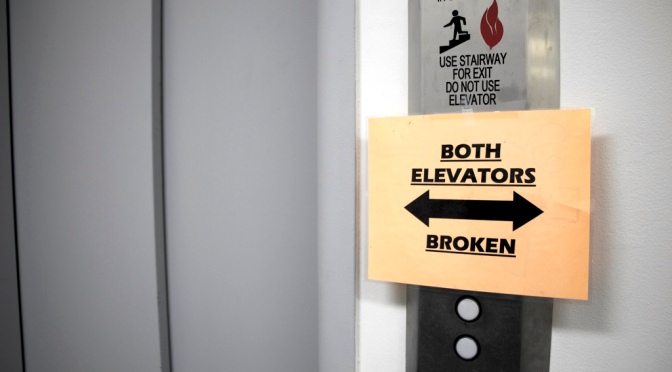Monica McCown
Staff Writer
Elevators throughout campus have been breaking down, malfunctioning and getting stuck. This has caused students to be trapped in elevators for long periods of time and has restricted those with either permanent or temporary disabilities who are unable to use stairs. There are over 40 elevators on campus and almost every elevator is unique, as they are all manufactured by about 5 different companies. The oldest elevator at USF, installed in the 1930s, is in Pedro Arrupe. The newest elevators on campus are in Lo Schiavo and are around 2 years old. Because almost every elevator on campus operates differently, it is difficult to diagnose the root causes of the malfunctions.
Elevators may be the only option for those with physical challenges who cannot use stairs. Alene Rose, a Fromm Hall resident who lives on the 5th floor, is one such student who sprained her ankle and was in so much pain that she could not move her foot. At the time of her injury, both elevators in Fromm were not working. “There’s no way I could’ve gone down and up stairs…so I didn’t have the option of going to any of my classes,” said Rose. Rose was forced to miss a day and a half of classes until the elevators were operational again.
Valerie Ong, Fromm Residence Director, lives on the fifth floor of Fromm Hall. Just in the past two weeks, she has dealt with 3 students on separate occasions who have been stuck in the elevator. Ong consistently reports elevator incidents and her staff has reported 10 incidents in this past semester alone. “We’ve had several students that have been on crutches and they have to take the stairs which becomes another safety hazard.” Students who attempt going down the stairs while on crutches creates another safety issue, as they can fall and worsen their injuries.
Craig Petersen, Director of Operations in Facilities Management, oversees engineers, landscapers, laborers, the mailroom, and the sustainability coordinator. He describes an obstacle in diagnosing and solving the problem; a new law states that the only thing that USF repair engineers are qualified to do is reset the elevators, and all other issues must be addressed by a state certified elevator technician.
Four years ago, USF was forced to change elevator service companies because of a corporate buyout. After this new company came to USF, there were far more cases of elevator malfunctions. On April 1, USF switched to San Francisco Elevator Company for contracting purposes, a company that Petersen is optimistic will be more reliable than the previous company. “They need to understand what the issues are in each of the different elevators and assess the problems,” Peterson said. “Each day they’re getting better and better.”
The root cause of all these malfunctions is difficult to diagnose because of the diversity of the elevators’ manufacturing, but there are ways to reduce the risk of system failure. A potential cause of elevator malfunctions is physically holding the elevator door open instead of pressing the door open button. When the door begins to close despite the physical barrier holding it open, the logic in the elevator’s computer’s circuitry will determine that there is a safety malfunction and shut the elevator down.
Also, there are issues with elevators carrying too much weight. This past Sunday, there was an incident with the main Lone Mountain elevator in which students were trapped for a few hours. When the fire department arrived and opened the doors, there were 16 students trapped inside. The number of people inside the elevator may have strained the elevator’s weight capacity. “In essence,” said Peterson, “the elevator was working as advertised; it’s the passengers who may have created the unsafe situation if they overloaded the elevator.”
Hayes-Healy’s elevators are especially temperamental and have been since their installation. Both elevators in the building will be taken out of service for 10 weeks during the summer for thorough repairs. The cars themselves will be placed back in service, but electronics, door operators and other supporting equipment will be replaced to ensure that the elevator meets updated regulation standards. The operation will cost around $400,000.
Peterson receives email notifications of all elevator malfunctions, 24 hours a day. “We will respond immediately if there’s an entrapment or a safety issue,” said Petersen. The facilities department responds first with an initial assessment. Then, if the problem is not solved, an elevator service technician will arrive within a few minutes and deal with the immediate safety concern. “I take that personally because…their time is just as important as my time,” said Petersen.
Photo courtesy of Racquel Gonzales/Foghorn

